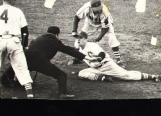14
Sidney Roy of Westville
1952
Albion Field, Stellarton, Nova Scotia

15
Already, however, the tensions between locals and imports were beginning to surface. When fire-balling pitcher Clyde Roy threw inside on Bobotas one afternoon, for example, Bobotas responded by calling him a "local punk". Boss dropped his glove, stormed the plate, picked Bobotas off the ground and slammed him flat on his back on home plate. After the game Boss approached Bev Buckler, one of Kentville's home-town players. "Bucky," he said, "I don't know why you continue playing with those bastards!"
The Central League Wildcats continued in a similar direction the following year with UNH baseball coach Hank Swasey at the helm. Kentville relied heavily upon players from the Northern League, including Bobotas, shortstop Johnny Watterson, outfielders Jack Kaiser (later chosen Varsity magazine's collegiate player of the year in 1949), Chris Tonery and Hal Burby. Swasey also worked closely with the Brooklyn Dodgers who arranged for pitcher Tom McMullen and veteran minor league catcher Paul O'Neill to join the club. The Dodgers also recommended hulking Temple University first-baseman Dick Gernert who would later play ten years in the major leagues, mostly in a Boston Red Sox uniform. The northern exodus grew as well because of a decision by the Eastern College Athletic Conference (ECAC) to declare the Northern League a professional league. Many of that league's players chose to come north rather than lose their collegiate eligibility.
16
Members of the Kentville Wildcats
1950
Kentville, Nova Scotia
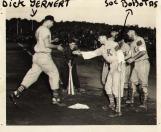
17
Composite photograph of the 1948 Kentville Wildcats
1948
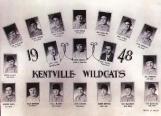
18
Len Boss, of Springhill, NS
1946

19
An increasing reliance on imports had actually begun in 1947. That year league president Harry Butler gave up his post as vice-president of the Nova Scotia Amateur Baseball Association to give "full attention to top quality ball for Halifax." Local sportswriter Alex Nickerson interpreted this to mean a high-priced circuit with an emphasis on imported players. He was right. The major sources of playing talent in the future would be the Northern League in Vermont and New Hampshire, the Albemarle League in the Carolinas, and college teams in both those areas as well as in Massachusetts, Connecticut, New York and Pennsylvania. The 1947 Kentville Wildcats, for example, signed 22 year old "Soc" Bobotas, from Manchester, New Hampshire, as playing coach. Accompanying Bobotas were a number of his teammates from the Northern League and the University of New Hampshire varsity. An exception was seventeen year old Art Ceccarelli, a left-handed pitcher from New Haven who would later play five seasons in the major leagues.
20
Group photo of the Halifax and District Baseball League umpire staff for 1950
1950
Wanderers Grounds, Halifax, Nova Scotia
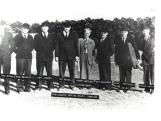
21
The success of the import-laden Wildcats in the Central league in 1947 and '48 had a ripple effect across the province. In 1948 Middleton Cardinals assembled a team largely made up of imported players from the Windsor-Detroit area, including veteran minor leaguers Buster Pankratz and Bernie Parent, youngsters Jim and John Wingo (sons of former major leaguer 'Red" Wingo) Frank Lerchen, Paul Bulger, Jack Graham, Nick Nikita and Jimmy Dumeah. Dumeah would settle permanently in Nova Scotia. Other imports on the club included Emmanuel "Sonny" Senerchia who was later signed and played with the Pittsburgh Pirates in 1952, and William 'Bucky" Tanner who had been blacklisted from major league baseball for jumping his contract and playing in the outlaw Mexican League in 1946. Tanner delighted fans by regularly appearing at the ball park in a wide-brimmed sombrero.
22
Bucky Tanner of the Middleton Cardinals.
1948

23
Four members of the Middleton cardinals stand in front of the dugout.
1948
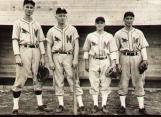
24
By 1949 many clubs were concentrating upon imported players. In Stellarton, manager Stuffy McInnis (once a member of the Philadelphia Athletics' famed $100,000 infield) had nine imports in tow to start the 1949 season. McInnis relied nonetheless upon local players Harry Reekie and John "Twit" Clarke, both of whom worked in the mines by day and played ball at night. "Stuffy, he couldn't get over it here in Stellarton," Clarke recalled. "He said 'I can't figure out how they do it. They work all day in the mines; they come up here; they have a shower and maybe grab a sandwich; and they play ball, and they play good ball'". McInnis was convinced that if Reekie would agree to go south with him that he had a good shot of making it all the way to the majors. But Reekie was happy playing in Stellarton along with friends like Sid Roy who won 25 games against only six losses in four years with the Albions.
25
Composite photograph of the 1950 Stellarton Albions.
1950
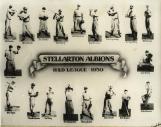
26
Two teams, the Halifax Shipyards and the Liverpool Larruppurs, bucked the trend and remained committed to local players. From the early days of the war and into the postwar years, Shipyards overlord R.J.R. Nelson had put together teams that drew heavily on local talent. In 1950 five local players, four of them members of the Shipyards, ranked in the top ten batters in the league. Condy led the league with a .358 batting average, followed closely by Johnny Clark at .350. "Red" Burchell stood in sixth spot in the batting race hitting .295 and Leo Woods was tenth at .285. On the mound the Yardmen were led by imports Jack Halpin with a 13 and 2 won-lost record and 2.44 ERA, and Frank Giaquinto at 8 and 1 and a 2.03 ERA. They were supported by locals 'Twit" Clark (5-3 and 1.66) and Len Boss (2-4 and 4.43).
27
Halifax Capital player slides safely into home plate.
1950
